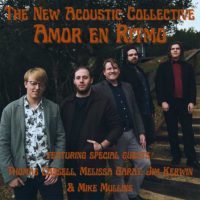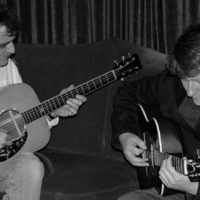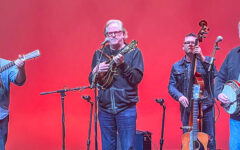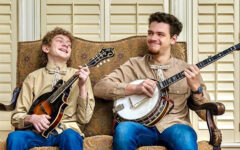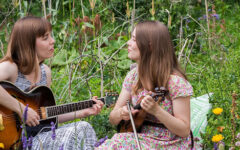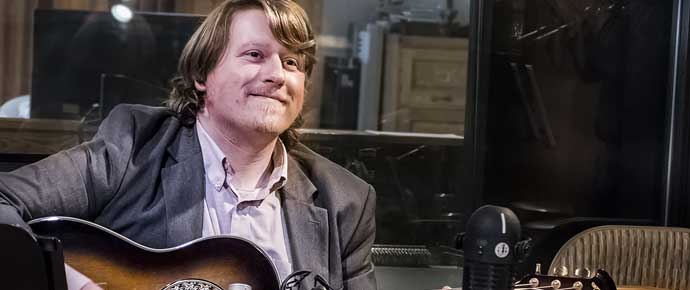
San Jose–based Jason Keiser is yet another in the suddenly burgeoning field of young players who easily crosses boundaries from jazz and bluegrass. He studied at East Tennessee State University with guitarist Wyatt Rice. Jason’s primary instrument is the guitar, on which he composes and arranges material for the New Acoustic Collective, which he founded. The extensive bio on his website lists his credentials, awards, mentors, and appearances.
Hi Jason. Tell us about your new release, Amor en Ritmo.
Hi Dave! Firstly, thank you so much for this opportunity. I’m excited to let everyone know that the New Acoustic Collective released our third record, Amor en Ritmo, featuring Thomas Cassell, Melissa Garay, Jim Kerwin, and Mike Mullins, on all platforms. The New Acoustic Collective separately released a new original single, Hop Dogma Stomp, which is a fun spacegrass tune I wrote featuring mandolinist Mike Mullins. I recommend you check it out! We also released a very special single, The 11th Cycle, composed by our cellist, Nathaniel Grohmann. This uniquely modern New Acoustic tune also features Mike Mullins on mandolin, and is Nathaniel’s debut as a composer with the New Acoustic Collective.
Mobius Mambo by the New Acoustic Collective (feat Thomas Cassell) from Amor en Ritmo
You studied both jazz and bluegrass at ETSU. Tell us how that came about.
Before transferring to the Bluegrass, Old-Time, and Country Music Studies program at ETSU, I was pursuing jazz studies at West Valley Community College in Saratoga, California. I’d been into jazz for a long time, ever since learning and playing it at Leland High School, in Almaden, California. At the time, jazz was the high school band class I could have the excuse to play my guitar in. I jumped at the opportunity and loved it right away.
When I was studying bluegrass, spacegrass, and new acoustic music with Wyatt Rice at ETSU, and taking bluegrass history and bluegrass band classes, I had to choose a minor emphasis as part of my graduation requirement. I immediately knew that jazz studies would be my music minor, and I immediately began pursuing my studies in jazz again. Pursuing jazz alongside bluegrass felt great, like normal, as I’d always pivoted between those two styles heavily. It was a wonderful way to get to know all the students and faculty in the ETSU music department and continue refining my jazz chops, which I used all the time when studying with Wyatt, and working on new acoustic, spacegrass, and dawg music.
How were those programs different?
The programs and requirements differed a ton. In the Bluegrass, Old-Time, and Country Music program I was learning about the history of bluegrass music, practicing in a totally different set of instrumentations, tempos, and keys than I was used to, and flat-picking, which felt so different than playing more jazz-horn-line-type melodies. The classes within the two programs were also very different in their approach, as the professors and instructors were all communicating from their areas of expertise. The two programs were not even in the same department.
Jazz Studies was located in the Department of Music, while Bluegrass, Old-Time, and Country Music Studies was located in the Appalachian Studies Department. In a lot of ways, the classes and students were different—everyone in their specific program was there to learn that specific class, technique, music, and skill, which was cool and interesting, but I sometimes felt like a fly on the wall, always wanting to learn different ways to communicate my ideas and points of view, from both jazz and bluegrass music! Both programs were superb, and they definitely gave me a ton of different knowledge that I still use to this day.
You studied with Wyatt Rice and composed some work with him. Tell us about that experience.
Having the opportunity to study and learn from Wyatt Rice was an incredible experience for me. Wyatt showed me how to improve my playing, timing, improvising, and tone just leading by example. When I started studying with Wyatt, I’d already been heavily into jazz and new acoustic music, but I didn’t have all the intricate melodies, subtle harmonies, and tunes down exactly from that canon of music. Wyatt helped show me those tunes, the finer details and ways in which Tony wrote pieces such as Waltz for Indira, Swing 51, Devlin’, Manzanita, and so many others. I already had a good feel on the guitar, but Wyatt definitely helped me refine my technique, timing, and tone, and gave me ways to think about music from a more simple and effective perspective.
Regarding composing and working with Wyatt, we became friends outside of our private lessons, talking about jazz and what we were listening to. I’d begun writing a tune, Back in California, in 2017 during winter break that I thought would be perfect for Wyatt and me as a guitar duet. We were taking inspiration from Tony Rice and John Carlini’s seminal record, River Suite for Two Guitars. Back in California was the first tune we worked up and recorded officially as a guitar duo.
Working with Wyatt in the studio was an absolute blast! I tend to play with a lot of energy, and the sessions were immensely inspiring, both in what we were playing together and just how much dang fun we both had! To study and then record with one of my favorite guitarists of all time was an incredible experience I cherish to this day. I hope we can continue those sessions and maybe even release an album of guitar duets one day.
In what ways do you view bluegrass and jazz as being very different and also the same?
Bluegrass and jazz music are both inherently different on the surface when considering basic instrumentation that normally rounds out the typical ensembles. At the same time, both musical forms are heavily based in improvisation, using the basic head chart as the “road map” for the framework of a tune. This is where I find some of the most beautiful similarities and areas for the fusion of both genres.
Tempo and chord changes can differ yet connect between the genres. Many old jazz tunes use chord changes such as the standard ii V I chord progression, which can also be heard in bluegrass, and the common I IV V I pattern heard in both genres.
Both have incredible musical challenges and so many wonderful examples of improvisation to learn from. Melodic embellishment and interplay within a live setting are so important to both genres, listening to each musician as they’re playing and interacting in the moment.
Your recent work is more jazz influenced. Do you feel a streak of traditional music in the foreseeable future?
That’s an interesting question. I think so! I have a solo guitar arrangement of the traditional bluegrass gospel tune, The Old Rugged Cross, that I’m really proud of. I transcribed all the different vocal parts from Dailey & Vincent’s Singing From The Heart album version, and arranged it all for solo guitar. I hope to release that at some point, and think people would really dig it.
I also would love to collaborate and do a bluegrass guitar duo record with some of my favorite players in the industry. I’m a big Tim Stafford fan, and hope to record some duos with Tim one day! I’m a huge fan of his songwriting, unique playing style, sound, and tone, as well as Blue Highway, which is one of my favorite bluegrass bands.
Old Gray Coat feat. Wyatt Rice
You’ve pulled in some excellent talent like Mike Mullins, Melissa Garay, Thomas Cassell, and Jim Kerwin for some tunes. Can you expand on what drew you to each?
Thomas Cassell and I met when we began our B.A. in Bluegrass, Old-Time, and Country Music Studies at ETSU in 2016. I remember when I met Thomas; it was the day of band auditions, and he just blew me away. I could hear and see that he was into a ton of different music, which is something I’ve and always look for in all the colleagues I want to work with.
Thomas and I had a great time working together both in the classroom setting and playing gigs. We’ve collaborated and recorded in many different instances since meeting. He’s a prolific mandolinist, composer, and bandleader and one of the most hard-working musicians I know. He’s also a total professional, very on top of things, with a great attitude, and he’s easy to work with. He keeps a very open mind musically and is willing to go with any ideas that will serve the music and moment! He continues to inspire me to work hard and make things happen, no matter what.
Jim Kerwin has been a pivotal force on the bass and a supporter of my band since we met and connected in 2017. At the time we met, I was on my winter break from ETSU, and I wanted to expand upon the new acoustic and dawg music that Wyatt Rice had been teaching me. I wanted to be able to play it with more people who really knew that music well. Jim Kerwin is a special and unique musician because he excels in so many different musical contexts, and always brings out his personal voice on the double bass in any musical situation, from bluegrass to dawg music, jazz, and beyond. He’s had the longest bass tenure position in the David Grisman Quintet, and I sought him out to learn and play dawg and jazz music together. We hit it off, and we’ve stayed in touch since 2017. When I was putting together the special guest lineup for the Amor en Ritmo album, I wanted to do my best to try and include current and former band members of the David Grisman Quintet, and Jim was at the very top of my list, along with Joe Craven and Matt Eakle, who I hope to collaborate with one day.
I met Melissa Garay when we were pursuing our Master of Music in Jazz Studies at San Jose State University in 2018. Melissa is a triple-threat professional musician. She has a unique voice and ability, a wonderful compositional voice, can arrange for multiple small to large ensembles, and is highly professional and ready for any challenge. Melissa and I hit it off right away and found a lot of similar connections in our love for Latin music, and for pushing musical boundaries in general. I’ve been collaborating, gigging, and recording with Melissa since 2018, and I knew she had to be featured with the New Acoustic Collective on the Amor en Ritmo record. I always had it in my mind that there would be no singing/vocals featured in the band, as instrumental music has always been my main focus for the group. But there were two pieces I had in mind to include on this album that would run cohesively with the Latin music themes. I knew right away that Melissa needed to be featured and highlighted on these tunes—Pequeña Avé, which Melissa wrote the lyrics to, and Black Orpheus by Luiz Bonfá.
I met Mike Mullins virtually when COVID was much worse. I found out about Mike, his great music, and mandolin playing after listening to his beautiful recording of Danza Calavera featuring Jim Kerwin and Joe Craven on his album Windows of Time. I really liked his playing and wanted to show him our music, and we hit it off! I sent him our second album, Art of Acoustics, and he’s been a staunch supporter of me, my music, and the New Acoustic Collective ever since. Mike is one of the most supportive people I have ever met in the music business. He means a ton to us and me as a collaborator and he’s a dear friend. Similarly to the other musicians and special guests on the new Amor en Ritmo album, Mike is not afraid to take risks, push boundaries, and try new things musically.
Mugavero (feat. Mike Mullins) Music Video
Obviously, David “Dawg” Grisman is a big influence. When did you first hear his work?
I first heard David’s dawg music back around 2013–2014 when I was at West Valley College, and his composing completely blew me away! David is one of the biggest influences on me as a composer. If there was no dawg music there’d be no New Acoustic Collective.
Talk about how Tony Rice has influenced your music.
Tony influenced and continues to influence me in my approach to flat picking and technical virtuosity, timing, precision, melodic development, and embellishment in my improvising. Even more so, Tony has impacted me as a composer. I remember hearing this quote that Tony said, which I’m paraphrasing: “I found out early on that I couldn’t play as Clarence did, so I had to find my own voice and way to communicate my ideas on the guitar.” This is how I feel when thinking about Tony’s playing versus mine. I’m not Tony Rice and never will be, so I better start thinking about how I might want things to sound, feel, and be for myself, because having one’s own voice on their instrument is as important to me as it was for Tony. I’d like to see more people taking what Tony did and expanding on it in their own musical way, including composing, improvising, phrasing, and using chordal substitutions. It would be great to see more people exploring the sound he was searching for, as John Coltrane was doing for his sound. Tony was a big fan of Trane, and it would be cool for people to dig deeper into Trane’s catalog and the other artists Tony loved to listen to, such as Bill Evans, NHØP, and Ernie Watts. Tony has impacted my mindset; he’s made me consider how I personally want to think and sound. If there was no Tony Rice, Tony Rice Unit, and spacegrass music, there would never be the New Acoustic Collective.
What instruments do you play?
I used to consider myself to be a multi-instrumentalist, but at this point, I almost solely play the guitar. I dabble a bit in mandolin, tres Cubano, banjo, and ukulele. Overall, the guitar is the final frontier for me. It’s the instrument I compose on, and it’s the most challenging instrument out of all of those, so my work is always cut out for me on the guitar. It will always be my main focus.
What music do you recall hearing growing up?
My dad is a huge music fan and always had a CD or something on the radio when I was growing up. One of his favorite artists is Bruce Springsteen, so I remember hearing a lot of Bruce, which was nice, as well as vocal jazz music and a variety of rock and folk. My grandpa was really into Creedence Clearwater Revival and Ray Charles, and that music was exciting to hear as I was growing up, and to dive into because it opened my ears a bit more to both folk and jazz-style sounds. There was not a whole lot of instrumental music being played around the house as I was growing up, but I do remember a pivotal moment looking in my family’s basement and discovering a John Coltrane compilation CD. John Coltrane is still one of my biggest influences.
Do you teach music? How do you motivate your students?
Yes, I do teach music, both privately through my own studio, and at three different music schools in the Bay Area. One day I hope to teach higher education. I have a goal of teaching jazz and developing a higher ed curriculum with classes for new acoustic, spacegrass, and dawg music.
As a private music instructor, I cater to each one of my students individually and try my best to scaffold their experience to find and achieve what’’s best for them. Motivation-wise, I highly encourage my students to take as much if not more time to actively listen to music rather than just practicing. Inspiring one another and finding what makes the students tick and get excited about is some of the most important motivators in my opinion.
Hop Dogma Stomp (feat. Mike Mullins)
Is there anything else you want to say or plug?
We have a show coming up Sunday, December 4, sponsored by Music in Place, live at the Donkey & Goat Winery in Berkeley from 1:00-4:50 p.m. Many thanks to Music in Place for their continued support of the New Acoustic Collective. Check them out and their wonderful mission to help support professional working Bay Area musicians online.
The New Acoustic Collective has a new single, Tynerism, featuring Mike Mullins and dedicated to McCoy Tyner. It’s a special spacegrass tune I composed and set for release on Sunday, December 11, which happens to be McCoy Tyner’s birthday. It’s a cool tune inspired by Tyner’s chordal vocabulary and use of quartal harmony, while also fusing elements of bluegrass music.
I have a new jazz sextet record, Shaw’s Groove, featuring John Stowell, Erik Jekabson, Aaron Lington, Dan Robbins, and Jason Lewis, coming out in 2023. I also have a new jazz guitar duet record featuring Mimi Fox, John Stowell, Rick Vandivier, and potentially more guests that’s also in the works currently. Stay tuned for new info on that and check out my most recent jazz guitar record, The Axe Axis, featuring Rick Vandivier and John Stowell, on all platforms.
Thanks for your time, Jason
Many thanks again Dave for having me!
